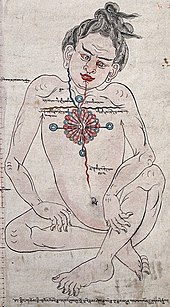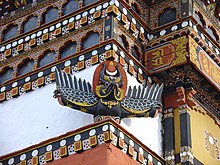Rigpa
A practitioner who has attained the state of rigpa and is able to rest in it continuously is called a Rigdzin or Rigma (see Vidyadhara), which may be used as a title either pre- or post-nominally.[14] Sam van Schaik translates rigpa as "gnosis" which he glosses as "a form of awareness aligned to the nirvanic state, free from all delusion".[15] He notes that other definitions of rigpa include "free from elaborations" (srpos bral), "non conceptual" (rtog med) and "transcendent of the intellect" (blo 'das).[15] The unconditioned nature of rigpa is described in the Longchen Nyingthig as follows: Not constructed by excellent buddhas, nor changed by lowly sentient beings, this unfabricated gnosis of the present moment, is the reflexive luminosity, naked and stainless, the Primordial Lord himself.[16]John W. Pettit notes that rigpa is seen as beyond affirmation and negation, acceptance and rejection, and therefore it is known as "natural" (ma bcos pa) and "effortless" (rtsol med) once recognized.[3] Vimalamitra's Commentary states that "because the aim of buddhahood exists in the manner of a seed in the pristine consciousness of one’s vidyā, there is definitely success through practice.[22] Dzogchen tantras also discuss the related topic of the energy body, mainly the nāḍīs, vāyus, and bindus (rtsa, rlung, and thig le; channels, winds and circles).[16] This lack of difference between these two states, their non-dual (advaya) nature, corresponds with the idea that change from one to another doesn't happen due to an ordinary process of causation but is an instantaneous and perfect 'self-recognition' (rang ngo sprod) of what is already innately (lhan-skyes) there.[24] According to John W. Pettit, this idea has its roots in Indian texts such as Nagarjuna's Mulamadhyamakakarika, which states that samsara and nirvana are not separate and that there is no difference between the "doer", the "going" and the "going to" (i.e. the ground, path and fruit).[citation needed] Citing Dodrupchen Jikme Tenpe Nyima, the 14th Dalai Lama states the full measure of rigpa occurs with the third vision.An important theme in Dzogchen texts is explaining how ignorance arises from the basis or Dharmata, which is associated with ye shes or pristine consciousness.[37]As Sam van Schaik notes, for authors like Longchenpa and Jigme Lingpa, the basis has the potential to manifest in both a samsaric and a nirvanic modes.Mind is the aspect of deceptive objects of fixation, vividly filling up, swirling round, and pouring out again, or briefly becoming agitated like a hurricane.Thus the essential point of the Seminal Heart is to hold a secure place in the natural state, utterly liberated from mind in the expanse of gnosis.[42]Longchenpa explains the difference thus: In brief, ‘‘mind and mental factors’’ refer to the arising of conceptualization and analysis of objects that is ostensibly causally produced by the subject-object dichotomy.[48] According to Thrangu Rinpoche, Rangjung Dorje (1284–1339), the third Karmapa Lama (head of the Karma Kagyu) and Nyingma lineage holder, also stated that the Ground is Buddha-nature.




Rigpa (organization)Tibetan BuddhismSchoolsNyingmaBodongJonangPadmasambhāvaŚāntarakṣitaKamalaśīlaSongtsen GampoTrisong DetsenRalpacanAtiśaTalikaAbhayakirtiNigumaSukhasiddhiMilarepaYeshe TsogyalLongchenpaJigme LingpaPatrul RinpocheDudjom LingpaMiphamRangjung DorjeDolpopaTaranathaSakya PanditaGorampaSamding Dorje PhagmoJe Tsongkhapa5th Dalai Lama13th Dalai Lama14th Dalai Lama10th Panchen LamaTeachingsThree marks of existenceSkandhaCosmologySaṃsāraRebirthBodhisattvaDharmaDependent originationFour Tenets systemRangtong-ShentongSvatantrika-Prasaṅgika distinctionDzogchenPointing-out instructionLamrimPāramitāsBodhicittaAvalokiteśvaraMeditationVajrayanaTantra techniquesDeity yogaGuru yogaDream yogaThukdamBuddhahoodMajor monasteriesTradrukDrepungGandenJokhangKumbumLabrangMindrollingNamgyalNarthangNechungPabonkaPalchoRalungRamocheTashi LhunpoTsurphuDalai LamaPanchen LamaKarmapaRinpocheTertönWestern tulkuFestivalsChotrul DuchenDajyurGaldan NamchotDosmocheMonlamSho DunLosoongKangyurTengyurTibetan Buddhist canonMahayana sutrasNyingma GyubumSand mandalaThangkaWall paintingsAshtamangalaTree of physiologyFestival thangkaMani stoneHistoryTimelineOutlineCultureIndex of articlesTibetanvidyāgroundavidyāVidyadharafundamental groundErik Pema Kunsangcrystal balljñānaprajñagnosisunconditionedLongchen NyingthigTibetan MedicinesamsaranirvanaLongchen Nyingtig
